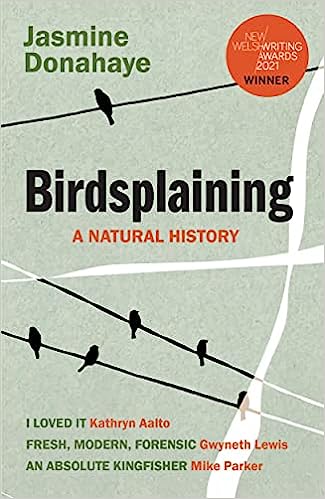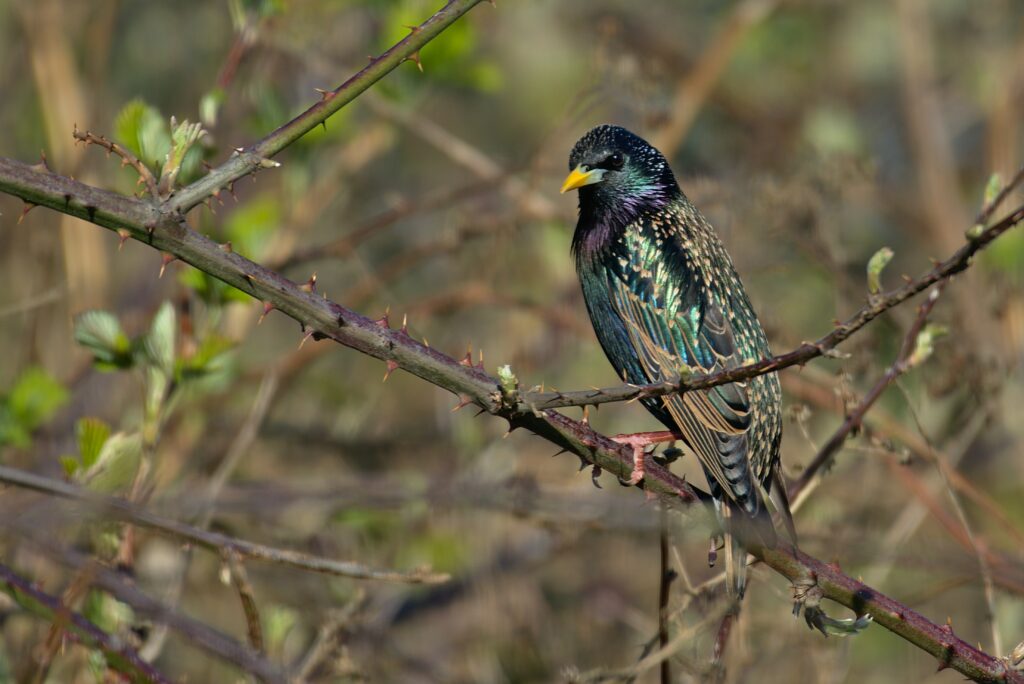Saskia McCracken reviews contemporary Welsh essayist Jasmine Donahaye’s new book of nature writing Birdsplaining
In her new essay collection Birdsplaining: A Natural History, Jasmine Donahaye attempts to remove ‘the men who have placed themselves, uninvited, between me and my experience of the natural world.’
The opening chapter is gorgeous, full of suggestions – ‘I know what a bird in the house means’ – and aching feelings: ‘I might have held her, I might have told her.’ It weaves together birds, grief, illness, domestic violence, sexism, and what forms nature writing can take. Then its tone changes from the allusive and poetic to a more conversational approach, as Donahaye explores these themes in depth.
Each of her fourteen chapters are part essay, part memoir. They all feature birds, which are sometimes central to her discussion, and sometimes peripheral, symbolic. Birds are the thread that binds her wide-ranging collection together. She finds that her love of birds gives her the courage to overcome her fears and challenge received ideas about how we can engage with the natural world.
Our ways of understanding the natural world, and who gets to shape that understanding are, as Donahaye demonstrates, not natural at all, but reflective of human patriarchal and colonial hierarchies.
The collection is well researched and the writing self assured. Donahaye is a professor at Swansea University and award-winning author. She also establishes herself in this work as an astute naturalist, of both birds and birdwatchers. She observes that birdwatching, and books on the topic, tend to focus on male birds. Bird guides often depict the males as larger, in varied postures, describe them in detail, and then throw in a small image and short description of the typically smaller, less colourful females (defined by what they lack in distinctive features) as an afterthought.
In one guide ‘‘the male always appears in the foreground, upright, and the female is horizontal or dipped downward or even crouching in the position she might assume for mating; half of her is always obscured by the male.’
Birdwatchers, including herself, she notes, often don’t feel they can properly tick a bird species off their must-see list until they have seen the male. Tropical birds are often named after male, colonial ornithologists (such as “Tristram’s Starling”) and birdwatching is typically seen as a (white) boy’s club.
Our ways of understanding the natural world, and who gets to shape that understanding are, as Donahaye demonstrates, not natural at all, but reflective of human patriarchal and colonial hierarchies. This ‘way of looking at the world had determined how [she] could see’ birds, or not see them, if they were female. The detailed examples that she gives are fascinating and, as an amateur bird enthusiast interested in feminist approaches to natural history, the book feels like it was written for me. I’m sure others will feel the same way – there are surprisingly quite a lot of us!
Discussions and debates that drive Wales forward.
Join Wales’ leading independent think tank.
Donahaye’s essays offer alternatives to these approaches to birds. She points out that the Bird Names for Birds campaign group calls eponyms (like Tristram’s Starling) ‘verbal statues’ to men. She suggests instead that ‘naming a species after a female feature might just redress the balance a bit, and perhaps it could change the way we look, and what we notice’. Her tone is acerbic, at times uncomfortably angry. For a book that endeavours not to be didactic it is clear that we, as readers, ought to be angry too – at the misogyny of the birdwatching community, at the patriarchy in general, at the male nature writers who make her ‘blood boil’. Sometimes discomfort is a good thing, but at times I wanted Donahaye to step back, and let me come to my own conclusions (which would, to be fair, have been quite similar to hers).
Birdsplaining is as much about what constitutes nature writing – which shapes how we look and what we notice – as it is about birds or her other themes, such as illness, domestic violence, and overcoming fear.
Donahaye has a beautifully conveyed passion for the unromantic aspects of the environment
Donahaye outlines two camps in the genre. In the first camp are traditionalists who, she says, are predominantly men whose nature writing strives to appear objective, authoritative, and to keep their authors in the background and nature in the foreground. In the second camp are books, often nature writing memoirs by women, which place humans and human issues at the centre of the narrative, such as Helen Macdonald’s H is for Hawk.
These works are often written in the confessional style, with themes of healing through reconnection with nature. Donahaye takes against traditionalist Jim Hinch who claims that ‘nature writing is over’ and that the genre has become ‘human-centred and inward looking’ when it should be the opposite.
 Personally, I quite enjoy both modes of writing, but for Hinch and Donahaye it’s either/or – you can’t have both. The two camps, Donahaye emphasises, are gendered, and epitomised by Robert Macfarlane on the one hand, and Kathleen Jamie on the other. Donahaye places herself in the latter camp.
Personally, I quite enjoy both modes of writing, but for Hinch and Donahaye it’s either/or – you can’t have both. The two camps, Donahaye emphasises, are gendered, and epitomised by Robert Macfarlane on the one hand, and Kathleen Jamie on the other. Donahaye places herself in the latter camp.
Her book, however, is neither human-centred nor its opposite. Although she explores human grief, violence and recovery, Donahaye also has a beautifully conveyed passion for the unromantic aspects of the environment – peat bogs, roadkill, pet parrots that have an eye for anything with buttons, and the animals that, uninvited but welcome, make a home in and around her own. She bridges the very gap that she identifies.
The strength of this book lies not in being entrenched in a particular strain of nature writing, but in Donahaye foregoing the camps, striking her own path, and taking the reader along it with her for a conversation, sometimes an argument, and plenty of birdwatching.
Birdsplaining (2023)
Jasmine Donahaye
All articles published on the welsh agenda are subject to IWA’s disclaimer.




